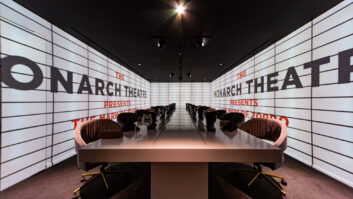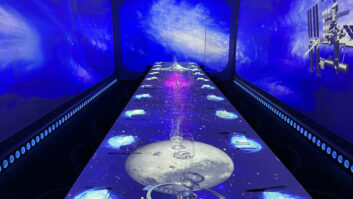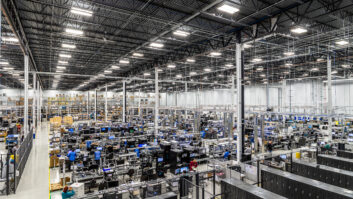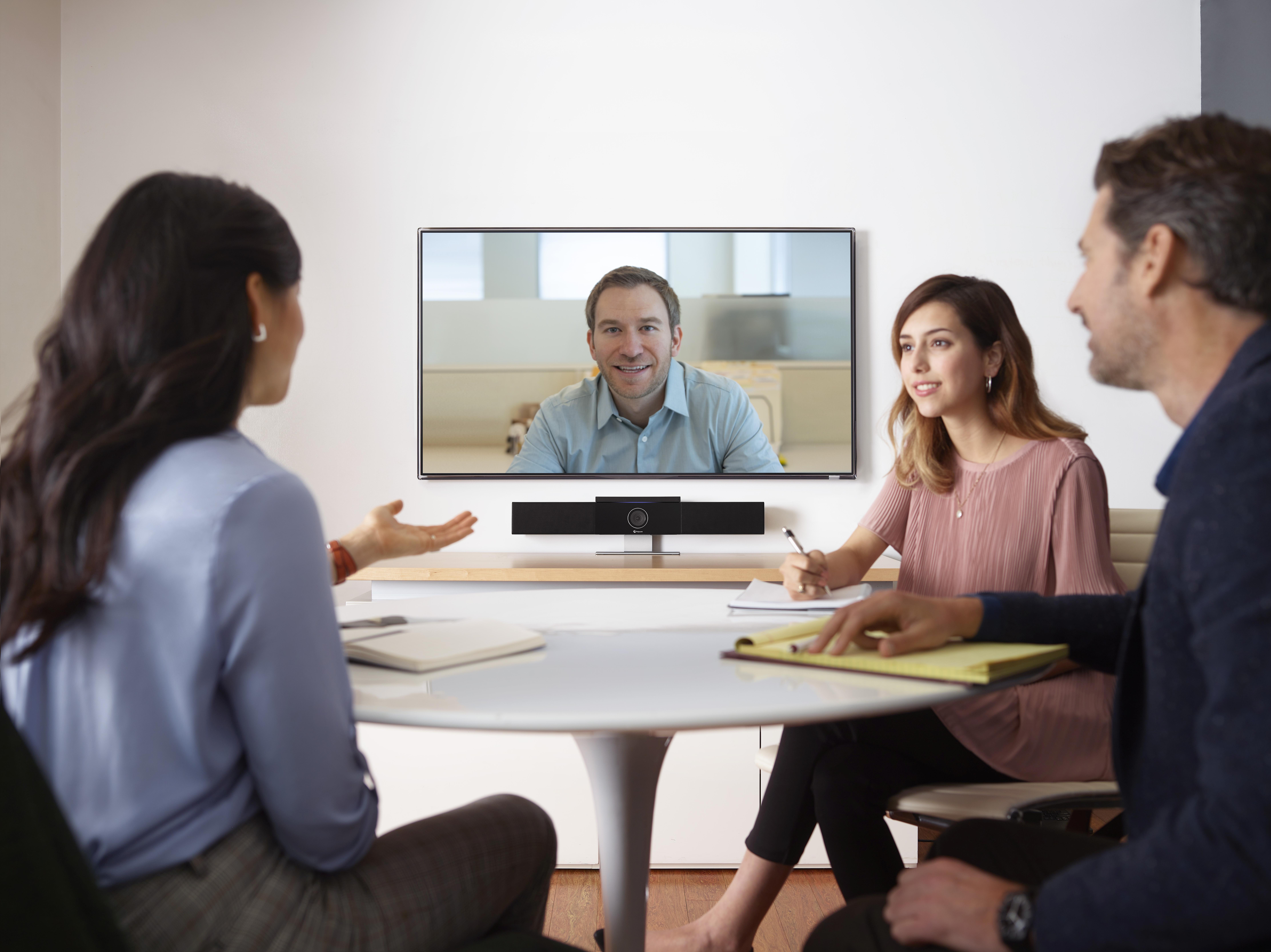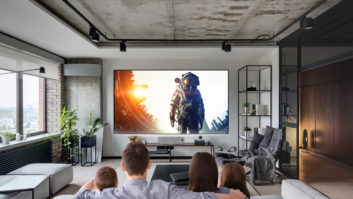The past eighteen months have seen a seismic shift in how movies are distributed, as cinema chains shuttered venues and studios looked for new ways to generate revenue. Old business models were dumped like unsold popcorn, with Warner Bros committing its entire 2021 cinema slate to day and date streaming on nascent OTT subscription platform HBO Max, the likes of Disney experimenting with Premium Access PPV for select titles on Disney+, and Netflix and Amazon routinely locking horns for screening rights, in what’s often appeared to be a filmic fire sale.
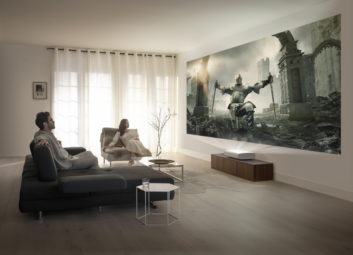 Now theatres are fighting back, with Tim Richards, founder and CEO of VUE Entertainment, going so far as to predict a ‘second golden age of cinema’. Speaking recently on The Evening Standard’s business podcast, he suggested Amazon’s purchase of MGM will herald a digital rejuvenation for the exhibition business: “Over the next 12-18 months we’re going to have almost three years of movies released and it’s going to be extraordinary.”
Now theatres are fighting back, with Tim Richards, founder and CEO of VUE Entertainment, going so far as to predict a ‘second golden age of cinema’. Speaking recently on The Evening Standard’s business podcast, he suggested Amazon’s purchase of MGM will herald a digital rejuvenation for the exhibition business: “Over the next 12-18 months we’re going to have almost three years of movies released and it’s going to be extraordinary.”
But as cinema chains play catch-up, what of the custom install home theatre business? Long story short: the prognosis is looking extremely good.
Following our investigation into the threat Covid posed to residential AV (Installation, February 2021), consumer electronic brands have posted strong equipment sales, and the installation market hasn’t just survived, it’s thrived, with high quality of streaming content persuading buyers to upgrade and invest in new immersive cinema systems.
Mike Beatty, CEO of Pulse Cinemas, reports a surge of interest from consumers eager to recreate the cinematic experience at home. “We’ve seen a notable increase in enquiries, sales and fantastic installations being created by many of our dealers,” he says. “I’m sure this is partially down to people spending more time at home over the last two years, but there’s now a wider cultural shift driving the business. We need to recognise that people are not just replacing a commercial cinema experience with a home experience. Home cinema has a momentum all of its own. Consumers recognise the value, regardless of their relationship with commercial cinema. The commercial cinema experience can be mixed, but all of our installations are high-performance. We’re often asked if our theatres are as good as commercial ones, we say, ‘No… they are way better.’”
CORE BUSINESS
Home Cinema has long been core to the Pulse operation, says Beatty. “We represent manufacturers that offer multiroom solutions, whether that be lighting, control, audio and video distribution, but our speciality has always been home cinema. From the beginning that was our main focus.”
What has changed over the past year is the definition of home cinema within the wider context of custom install, he says.
“It’s important to recognise that the description fits a wide variety of projects these days. Yes we do dedicated cinema rooms, but we also deliver systems woven into multi-use living spaces, working closely with interior designers. Home cinema is changing and we can deliver to a whole range of needs; whether discrete or on show.”
Nic Black, managing director of The Pyramid Group, echoes Beatty;s comments: “We’ve also seen an uplift of interest in cinemas of all scales. We have circa 10 cinema projects in varying stages at the moment, and this represents an uplift of over 200 per cent compared to this time last year!”
FLOATING UPSTREAM
An uptick in streaming time has kept the AV market buoyant, reasons Matt Nimmons, managing director of CEDIA EMEA. “Ofcom’s annual study of the nation’s media habits bears out the feedback we’ve been picking up from the market,” he says. “With people across the UK under some form of lockdown restrictions, the daily viewing average rose to five hours and 40 minutes, 47 minutes more than in 2019. Ofcom says that this change was mainly driven by people spending almost twice as much time watching subscription streaming services such as Netflix, Prime Video and Disney+.”
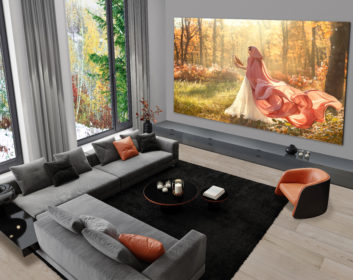
Arnaud Destinay, director of sales for Trinnov Audio, similarly confirms a “massive interest spike” over the past 12 months. “2021 is looking even more solid than last year,” he says. “People interested in home theatre are keen to recreate the cinematic experience, but whether it’s particularly driven by their interest in new blockbusters remains to be seen. I would say it’s mostly driven by the ever-growing need for convenience and comfort.”
Significantly, Trinnov has identified a new breed of business emerging globally, one that blurs the line behind commercial and residential projects. [For more on this, see our special report on pro and residential technology cross-overs, on page 46 of the October edition.]
“We have been involved in many fantastic home cinema projects all around the world, but the ones that really captured our intention were two projects in Russia and the Netherlands,” he says. “These are not only a new breed of cinema but also new business models that Covid somehow created. We call them ‘VIP Cinemas’; the simple concept is to take the best of both worlds and fill the gap between commercial and home cinema. Think of a room that combines the comfort, intimacy and convenience of a high-end home cinema, with the added benefit of theatrical releases. While most people could not afford such a room and system, many would be interested in renting it. That’s the concept behind this new model.”
EVOLVING INSTALLS
One brand taking a fresh look at the changing requirements of custom install theatres is StormAudio, which has recently launched its most affordable home theatre processor, the ISP Core 16, and an AoIP module for its current ISP MK1/2 platforms. “Not everyone needs a fully modular processor capable of managing 32 channels, like the StormAudio ISP MK2,” explains CEO Olivier Thumerel. “To enable more customers to experience the essence of what makes StormAudio unique, we worked on a simplified version of our platform optimized to power 16 channels. It packs all the features required to be at the heart of all immersive theatres under 16 channels and will set a new reference for these installations.”
As for Audio over IP, Thumerel says “usage is growing rapidly in pro, residential and marine applications. We felt it was key to have our own solution and be able to connect easily to any AES67 compatible server (for example, Dolby DCI servers) and any AES67 amplifier or speaker. We have been happily surprised by the demand for these solutions since we launched the new module.”
“Home Cinema has actually now moved more to a broader entertainment space,” notes Thumerel. “Most content now is mixed in multichannel. Whether movies, series or games, they all benefit from a Dolby Atmos or DTS:X immersive mix, driving the need to have a decent reproduction setup at home. Also, when you look at the recent move of Dolby to music with the Dolby Atmos Music ecosystem that you can now access on platforms like Apple, it’s clear that the home cinema is the right place to enjoy this kind of content.”
COMPACT CINEMAS
For many integrators, premium theatrical projects are no longer limited to larger venues. Compact spaces can deliver just as good a performance as larger rooms, says Mike Beatty.
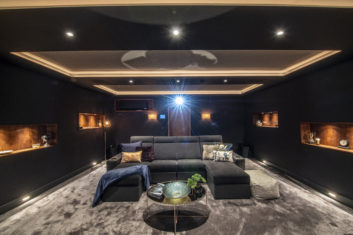 “It really comes down to the specific needs of the client and what real estate they have available. We have seen a real mix of solutions over the years, but I will always say that it really depends on the needs of the client, the spaces and budget they have available. Proper consultations with clients are of paramount importance if we are to create the very best solutions for them to enjoy.”
“It really comes down to the specific needs of the client and what real estate they have available. We have seen a real mix of solutions over the years, but I will always say that it really depends on the needs of the client, the spaces and budget they have available. Proper consultations with clients are of paramount importance if we are to create the very best solutions for them to enjoy.”
Nic Black, of The Pyramid Group, adds: “We have had some fun client requests for themed cinemas over the years and most recently, we created a hidden cinema behind a bookcase. The way in which the client wished to enter this space was to pull a book on one of the shelves whereby the bookcase split in half and revealed the room. The book was ‘The Hidden Cinema’ by James C Robertson!”
MEDIA ROOMS
In 2021, there’s been a clear move to media rooms, which bring new user benefits, says Nick Fitche, business manager for L-Acoustics Creations. “I think in some cases dedicated rooms can be used less, as families spend more time in open plan living spaces and with the quality of systems in those spaces becoming better.”
Sometimes it pays to not only think outside the box, adds Fitche, but outside the house. “In early 2021 we had an integrator bring a client to our London showroom for a demonstration,” he recalls. “We started discussing the home cinema aspect of the project, and the perfect solution for the space and how we could design it. We started then discussing how our products were IP rated so they could be used in the garden. As a result, what started out as being a garden music solution became ‘can we make the garden a surround sound zone as well?’
“So while not technically a cinema room, the client can now watch movies, sports or other events on
their 75-inch Samsung Terrace with a 12.1 L-Acoustics surround sound system driven by a Storm Audio processor, oh and did I mention, the .1 is actually made up of six 12-inch subwoofers?”
ENHANCED SPACES
“For us, entertainment at home has been hugely important,” says Simon Fulstow, design & technical director of custom installer SONA. “Our whole mantra is to enhance life at home and help those spaces where you spend time be more responsive and able to give you whatever you need at that moment, whether that’s entertainment, security, luxury or peace and quiet! Entertainment obviously plays a large role in that and the last 18 months have shown us how important time at home is and people are investing in technology to enhance that time.”
“We try not to talk about the actual tech at all with our clients if we can,” he says. “It should be all about the experience, and how we can enhance time at home. I’d go so far as to say that the majority of our clients aren’t actually interested in the really technical side and are actively looking to put their trust in our ability and experience to create incredible solutions for them.”
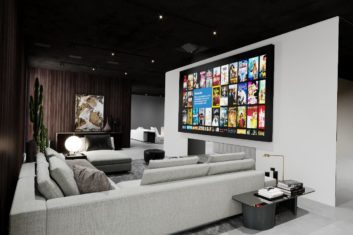 When it comes to the upsell, Fulstow lets the content do the talking. “One of the points we make to our clients about having a higher performance immersive audio and video system at home, is that they will fully appreciate the small screen content. Providers such as Apple, Netflix and Sky are producing content with the same and in some cases higher budgets as blockbuster movies – take Michael Bay’s
When it comes to the upsell, Fulstow lets the content do the talking. “One of the points we make to our clients about having a higher performance immersive audio and video system at home, is that they will fully appreciate the small screen content. Providers such as Apple, Netflix and Sky are producing content with the same and in some cases higher budgets as blockbuster movies – take Michael Bay’s
6 Underground on Netflix, for example, which has a budget of $150million – all delivered in 4K with Dolby Atmos. The majority of people are watching this content on a standard 50-inch TV and not getting
the full experience.
“There is now more content being produced by streaming providers, than big movie studios in Hollywood. The only way to experience this at home, so that is where the experience should be. We’ve demonstrated clips from Game of Thrones in a dedicated home cinema space and clients have literally been blown away by the audio and video experience that’s available. You can’t go to the cinema and watch the majority of these shows or films – so the only way to fully experience them is via a media room or home cinema system.”
Habitech’s Sophie Graham echoes the growing influence of streaming. “It’s now the predominant mode of delivery. Along with greater choice and convenience, there’s also a greater awareness of
cable quality and speed from integrators, who are now turning to high-speed CAT or fibre in their cable designs.”
Graham cites a leap in panel technology as well as architectural speaker performance, as a big fillip for home cinema suppliers. “Media rooms are informal spaces combining cinema with a snug living area, so the AV needs to be unobtrusive. That you can effectively hide full-range audio systems within walls and ceilings has given the media room concept a big push, especially when completely invisible speakers are now able to rival visible boxes for frequency range and dynamic response – as we’ve experienced with the Sonance ‘Motion Flex’ range. Today the performance potential of ultra-discreet full-fat systems for media room applications has never been greater.”
IMMERSIVE AUDIO
“From our standpoint, the most important event that happened in the last 18 months was Apple’s spatial audio announcement in July,” says Trinnov Audio’s Arnaud Destinay. “It’s reshaping the music production industry at a pace we could have not imagined. Enjoying a massive catalogue of music in immersive sound will definitely help and further accelerate the adoption of immersive audio in home theatres.”
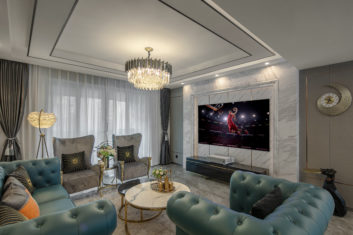 Mike Beatty of Pulse points to the latest wave of Ultra Short Throw projectors, as another catalyst for new business. “Products such as UST projectors are gaining momentum, with designs that make them much more aesthetically cohesive with room interiors. Projectors historically may have performed well but they never really looked that good, so it’s easy to see why there was a need to make those improvements.”
Mike Beatty of Pulse points to the latest wave of Ultra Short Throw projectors, as another catalyst for new business. “Products such as UST projectors are gaining momentum, with designs that make them much more aesthetically cohesive with room interiors. Projectors historically may have performed well but they never really looked that good, so it’s easy to see why there was a need to make those improvements.”
It’s not just movies pulling in the business either. Gaming has moved into the driving seat, and not only powered by next gen consoles like the Xbox Series X and PlayStation 5.
“Movies will always be as popular, but we are also seeing a real increase in gaming solutions,” says Mike Beatty. “So much so we have recently diversified our offering with our new company Pulse Simulations. It’s worth pointing out here that there is a useful distinction to be made between gaming and simulation. Our driving sims are next level and genuinely create the feeling of being inside a racing car, simulating g-force and providing a totally immersive experience.
“More mainstream gaming is of course very important, with game titles lending themselves hugely well to a high-performance home cinema environment. Increasingly our dealers find customers asking for a gaming element up-front.”
MICRO MOVIES
L-Acoustics’ Nick Fitche highlights Micro LED technologies, as championed by Samsung, and DV-LED from LG Display. “These LED screen technologies are fantastic, but placement of loudspeakers is a challenge,” he says. “When I first experienced our Island product I saw the huge potential of pairing it with an LED screen. The loudspeakers are all in the right place, right in front of you and around you, the screen can then be in front of that and the two products work in perfect harmony for the ultimate immersive experience.”
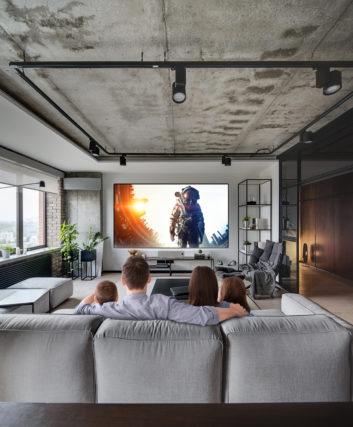 Also on the challenge posed by Micro LED, Trinnov Audio managing director Jon Herron adds: “One of the challenges they present is getting the sound from the centre channel to appear to come from the middle of the big screen rather than above or below. The same technology may need to be applied to all screen channels in wall-to-wall installations. In our view, it will be extremely important to solve this properly. After all, why invest in such a remarkable picture without also supporting it with the best sound quality The combination of size, picture quality, and usability in well-lit environments will be eye-opening for people when they see these video walls in real life.”
Also on the challenge posed by Micro LED, Trinnov Audio managing director Jon Herron adds: “One of the challenges they present is getting the sound from the centre channel to appear to come from the middle of the big screen rather than above or below. The same technology may need to be applied to all screen channels in wall-to-wall installations. In our view, it will be extremely important to solve this properly. After all, why invest in such a remarkable picture without also supporting it with the best sound quality The combination of size, picture quality, and usability in well-lit environments will be eye-opening for people when they see these video walls in real life.”
“What the new generation of Micro LED screens gives us is the option to get a bright image with great black levels in a bright or multi-purpose environment, but it comes at a significantly increased cost in terms of hardware and installation,” cautions Stuart Tickle, managing director of distributor AWE. “A giant Micro LED screen will definitely be right for selected projects, but bearing in mind you can get a DCI P3 10,000 lumens projector on a 4m-8m screen for a quarter of the price, or a decent image in a dim room using an ALR projection screen for a fraction, you really need to want to view in a bright environment to get the benefits.”

